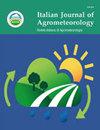城市景观中油橄榄潜在生境预测
IF 0.8
4区 农林科学
Q2 AGRONOMY
Italian Journal of Agrometeorology-Rivista Italiana Di Agrometeorologia
Pub Date : 2021-01-01
DOI:10.36253/ijam-1071
引用次数: 0
摘要
俄罗斯橄榄(Elaeagnus angustifolia)是一种原产于南欧、中亚和东亚的树种。由于其生长迅速,对恶劣气候的抵抗力和对人为压力的耐受性,该物种在城市景观设计中发挥着重要作用。了解其潜在的扩散和限制参数是可持续利用该物种的第一步。本文利用物种分布模型预测了俄罗斯橄榄在伊朗气候中的潜在分布,并估计了其传播的可能限制因素。我们的研究结果强调了气候因素、土壤和岩性等环境变量对该物种在全国范围内分布的重要性。根据这些结果,适合俄罗斯橄榄的栖息地位于伊朗北部沿着Alborz和Koppeh-Dagh山脉。因此,适合这种物种的栖息地仅限于全国的百分之九。栖息地适宜性图可用于评价城市地区的未来发展,并预测俄罗斯橄榄树在伊朗的扩散范围。我们的研究结果表明,俄罗斯橄榄树可以用来在伊朗北部地区的城市气候中创造新的绿色空间。本文章由计算机程序翻译,如有差异,请以英文原文为准。
Predicting the potential habitat of Russian-Olive (Elaeagnus angustifolia) in urban landscapes
Russian-olive (Elaeagnus angustifolia) is a species native to southern Europe and central and eastern Asia. This species plays an important role in urban landscape design because of its rapid growth, resistance in harsh climates and tolerance to human-caused pressure. Understanding its potential dispersal and restricting parameters are the first steps toward the sustainable use of this species. Here, we used Species Distribution Models to predict the potential distribution of Russian-olive in Iran climate and estimate the possible limiting factors for its spread. Our results highlighted the importance of environmental variables including climatic factors, soil, and lithology in the distribution of this species throughout the country. According to these results, suitable habitats for Russian-olive are located in the north of Iran along the Alborz and Koppeh-Dagh mountain ranges. Therefore, the suitable habitats for this species are limited to only nine percent of the country. A habitat suitability map can be used to evaluate future developments in urban areas and predict the dispersal range of Russian-olive in Iran. Our results show that Russian-olive can be used to create new green spaces in urban climates in the northern regions of Iran.
求助全文
通过发布文献求助,成功后即可免费获取论文全文。
去求助
来源期刊

Italian Journal of Agrometeorology-Rivista Italiana Di Agrometeorologia
AGRONOMY-ENVIRONMENTAL SCIENCES
CiteScore
2.10
自引率
8.30%
发文量
6
期刊介绍:
Among the areas of specific interest of the journal there are: ecophysiology; phenology; plant growth, quality and quantity of production; plant pathology; entomology; welfare conditions of livestocks; soil physics and hydrology; micrometeorology; modeling, simulation and forecasting; remote sensing; territorial planning; geographical information systems and spatialization techniques; instrumentation to measure physical and biological quantities; data validation techniques, agroclimatology; agriculture scientific dissemination; support services for farmers.
 求助内容:
求助内容: 应助结果提醒方式:
应助结果提醒方式:


